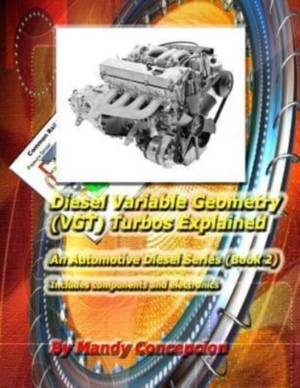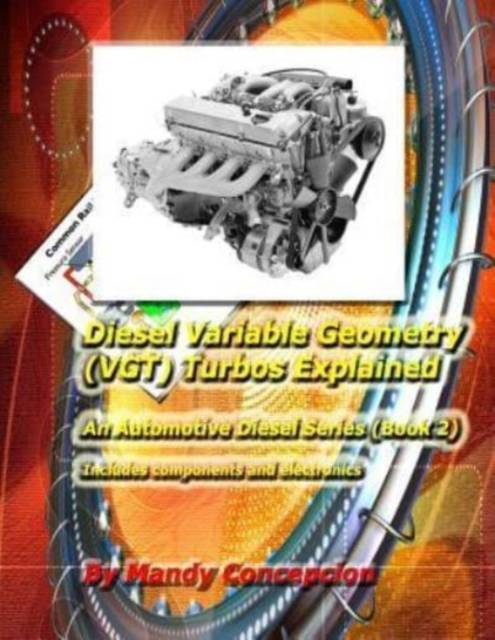
- Retrait gratuit dans votre magasin Club
- 7.000.000 titres dans notre catalogue
- Payer en toute sécurité
- Toujours un magasin près de chez vous
- Retrait gratuit dans votre magasin Club
- 7.000.0000 titres dans notre catalogue
- Payer en toute sécurité
- Toujours un magasin près de chez vous
Diesel Variable Geometry (VGT) Turbos Explained
Includes VGT components and electronics
Mandy Concepcion
Livre broché | Anglais
30,95 €
+ 61 points
Format
Description
The role of the modern automotive technician has changed drastically in the past decade. The job of today's vehicle specialist involves a deep knowledge of a wide variety of technical disciplines. Few professions encompass such a diverse understanding of technology. The automotive technician is now expected to know about chemistry, electronics, mechanics, optics, as well as posses a deep analytical mind. The last only comes with time and experience.This book contains a wide array of automotive applications. Emphasis is placed on a practical approach, with the theory to back it up as well. It is, however, expected that the technician already has a basic understanding of automobiles and electronics in general.Special thanks are giver to Carmen Diaz for her invaluable input and patience during the proofreading and editing of this book. She's also instrumental in the support role of the book.Table of ContentsVariable Geometry Turbo (VGT) Introduction (An introduction to the VGT or Diesel Variable Geometry Turbo chargers developed to circumvent the drawbacks of turbo technology. This section is full with details on specific pressure values and operation. See how they compare to older regular turbos using actual shots and CG animation technology.)Diesel VGT Turbo Facts (Purely factual information on aperture ratio, aspect ratio, exploded computer animation view, pumping loses, lag time and low boost threshold specifications. Get an in depth short view on VGT turbo units.)Diesel VGT Details 1 (Detailed a basic explanation on part-1 of how these units change their geometry during operation. See how parts interlink with each other. This is a primer for VGTs and the first book section on VGTs facts)Diesel VGT Details 2 (Extremely Detailed part-2 of how these units change their geometry during operation. See how parts interlink with each other. See the system is operation from different angles to visualize their operation.)Diesel VGT Turbo Disassembly and Inspection (Details on disassembling and inspecting the variable geometry turbo chargers section using actual real world chots and CG imaging animation to show concepts. Learn how to mark parts for orientation, align the unison ring and inspect the unit.)Diesel VGT Turbo Cleaning and Assembly (Get the scoop on cleaning and assembling the VGT turbo units. Learn to clean the sender, unison ring, housing, recess cam area and prep the unit for assembly. Finally, learn to assess the VGT alignment and operation from a visual inspection before releasing the unit. ) Diesel VGTs Turbo Failures (See which parts tend to fail on a VGT turbo unit. Learn from actual tech derived anecdotes compiled during a few years of work. See how heat issues shortens the life of these components.)Diesel VGT Turbo Vacuum Actuator OBD-2 Monitor (Sheds lots of information on the VGT vacuum actuator (when employed) as it relates to the OBD-2 diagnostic system. These VGTs employ no feedback sensor and the MAP sensor is used instead. See how it all works using waveforms and graphing interpretations.)Diesel VGT Turbo Electronic Actuation Basics (Explains the more precise electrical actuation of the VGT turbo mechanism as opposed to hydraulic actuation. See how its wired to the ECM and how a feedback position sensor is used. See why and how electrically controlled VGTs operate.)Diesel VGT Turbo Position Sensor Test (Learn about the specific electrical characteristics and voltage values of the VGT electrically controlled systems. This section explains about voltage reference, feedback values and grounds relating to the VGT turbo control.)Diesel VGT Turbo Speed Sensor Test (These units are so well developed that a turbine speed sensor is also used to provide the ECM with turbo speed values. This sensor is also used to prevent over speed and control the boost. See how a magnetic or Hall-Effect sensor is used to determine parameters.)
Spécifications
Parties prenantes
- Auteur(s) :
- Editeur:
Contenu
- Nombre de pages :
- 46
- Langue:
- Anglais
Caractéristiques
- EAN:
- 9781470021146
- Date de parution :
- 08-02-12
- Format:
- Livre broché
- Format numérique:
- Trade paperback (VS)
- Dimensions :
- 216 mm x 279 mm
- Poids :
- 131 g

Les avis
Nous publions uniquement les avis qui respectent les conditions requises. Consultez nos conditions pour les avis.






